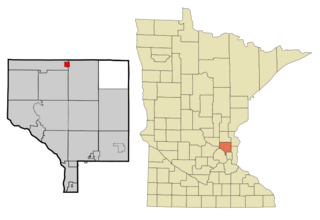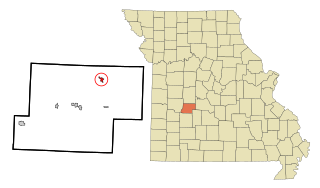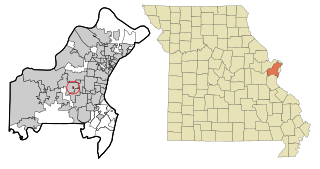
Bethel is a city in Anoka County, Minnesota, United States. The population was 466 at the 2010 census.

East Bethel is a city in Anoka County, Minnesota, United States. The population was 11,786 at the 2020 census.

Waltham is a city in Waltham Township, Mower County, Minnesota, United States. The population was 151 at the 2010 census.

Cross Timbers is a city in Hickory County, Missouri, United States. The population was 119 at the 2020 census.

Airport Drive is a village in Jasper County, Missouri, United States. The population was 766 at the 2020 census. It is part of the Joplin, Missouri Metropolitan Statistical Area. The community is still commonly referred to as "Stone's Corner," as the intersection of Route 43 and Route 171 is known.

Flemington is a village in Polk County, Missouri, United States. The population was 148 at the 2010 census. It is part of the Springfield, Missouri Metropolitan Statistical Area.

Bellerive Acres is a northern suburban city in St. Louis County, Missouri, United States. The population was 188 at the 2010 census. In April, 2015, the residents voted to change the village of Bellerive to a fourth class city named Bellerive Acres.

Country Life Acres is a village in St. Louis County, Missouri, United States. The population was 74 at the 2010 census.

Glen Echo Park is a village in St. Louis County, Missouri, United States. The population was 160 at the 2010 census. The community took its name from the Glen Echo Country Club.

Pasadena Park is a village in St. Louis County, Missouri, United States. The population was 470 at the 2010 census. It is part of the Normandy School District, and is distinct from the city of Pasadena Hills.

Twin Oaks is a 4th class city in St. Louis County, Missouri, United States. The former Village of Twin Oaks changed its status to that of a city by public election in November 2016. The population was 392 at the 2010 census.

Wilbur Park is a village in St. Louis County, Missouri, United States. The population was 439 at the 2020 census.

Phillipsburg is a village in Laclede County, Missouri, United States. The population was 202 at the 2010 census.

Champ is a village in St. Louis County, Missouri, United States. The population was 10 at the 2020 census.

Hanley Hills is a village in St. Louis County, Missouri, United States. The population was 2,101 at the 2010 census.

Uplands Park is a village in St. Louis County, Missouri, United States. The population was 445 at the 2010 census. The village is one of many small majority black communities located in the Natural Bridge corridor of mid-St. Louis County, characterized by small homes on small lots.

Bethel is a village in Tate Township, Clermont County, Ohio, United States. The population was 2,620 at the 2020 census. Bethel was founded in 1798 by Obed Denham as Denham Town, in what was then the Northwest Territory. Bethel is the home of the first movie theater in Ohio which was founded in 1908.

Riverlea is a village in Franklin County, Ohio, United States, surrounded by Worthington on its north, south, and east sides, and bordered on the west by the Olentangy River, across which is Columbus. Riverlea was incorporated in 1939, a small community that formed on former farmland. The population was 599 at the 2020 census.

Aurora is a city in Marion County, Oregon, United States and is home to the nation's largest not-for-profit air ambulance company, Life Flight Network. Before being incorporated as a city, it was the location of the Aurora Colony, a religious commune founded in 1856 by William Keil and John E. Schmit. William named the settlement after his daughter. The population was 1,133 at the 2020 Census. It is part of the Salem Metropolitan Statistical Area.

Wien is a town in Marathon County, Wisconsin, United States. It is part of the Wausau, Wisconsin Metropolitan Statistical Area. The population was 825 at the 2010 census. The unincorporated community of Wien is located in the town.
Nordhoff, Charles. The Communistic Societies of the United States from Personal Vision and Observation.... 1875. NY: Schocken Books, 1965.
Hinds, William. American Communities and Co-Operative Colonies. Chicago: Charles H. Kerk & Co., 1908.





















